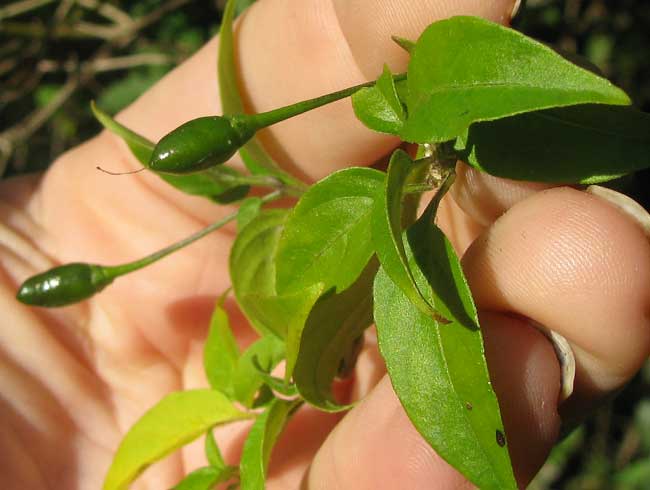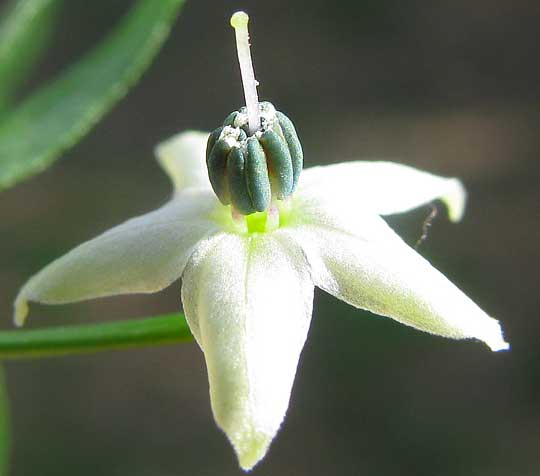Excerpts from Jim Conrad's
Naturalist Newsletter

from the January 17, 2010 Newsletter issued from Hacienda Chichen Resort beside Chichén Itzá Ruins, central Yucatán, MÉXICO; limestone bedrock, elevation ~39m (~128ft), ~N20.676°, ~W88.569°
MAAX, THE FRIENDLY HOT PEPPER
Growing wild at woods edges, along trails and just here and there you find woody, densely and finely branched bushes from waist to head high absolutely covered with pea-sized hot peppers, as shown above. Those peppers, though very small as peppers go, are already as large as they'll get. When they're fully mature they'll turn bright red, though usually you don't see many red ones nowadays because birds eat them. Despite their green color, the ones in the picture are as "hot" as anyone would wish.
I put "hot" in quotation marks to reference the fact that our English language, derived from a people to whom haute cuisine was just something eaten in France, is so impoverished of culinary terms that it offers just one word, "hot," for both heat and the biting sensation that this kind of pepper bestows. Not only that, but we just have one word, "pepper," for both the kind of fruit in the picture, and the black stuff that shakes from our "pepper shakers." Spanish calls heat-hot "caliente," and pepper-hot "picante."
Anyway, of the very many hot pepper cultivars, most are derived from the herbaceous annual Capsicum annuum, while most of the rest arise from the woody perennial CAPSICUM FRUTESCENS. The one in the picture is the wild form of the latter. From our Capsicum frutescens some important cultivars have been developed, among them various cherry peppers, cone peppers, red cluster peppers, the long peppers which includes Cayenne, and the bell or sweet peppers.

Above you see Maax's flower. The blue items are the five stamens' anther, each anther composed of two compartments. Wildflower lovers may ask how this flower of the genus Capsicum is different from a nightshade flower, in the genus Solanum. In Solanum the anthers grow together into a cylinder surrounded the slender, stigma-topped style in the center. Capsicum's anthers aren't "fused."
Here on any forest walk you can pluck a single little pepper from this plant, which may bear a hundred or more, and that one pepper will supply all the masticatory diversion your mouth can deal with. For several minutes your stomach will glow with that sweet warmth any good hot pepper imparts. The Maya call our woody-stemmed pepper Maax (pronounced "maash," rhyming with "posh," with the "a" sound a little drawn-out).
If Maya men are working in the woods when lunchtime comes they may bring out a bowl, drop in some masa (very finely ground cornmeal moistened and formed into paste) or Maseca (commercially sold bags of very finely ground cornmeal from which low-grade corn tortillas can be made), add some water and stir until an emulsion is formed, then toss in a few crushed Maax peppers, and finally they'll pass the bowl around. That sates the hunger like nothing else, and what a pleasure to work in the woods with Maax riding in your stomach like a pool of glowing-warm gravy.